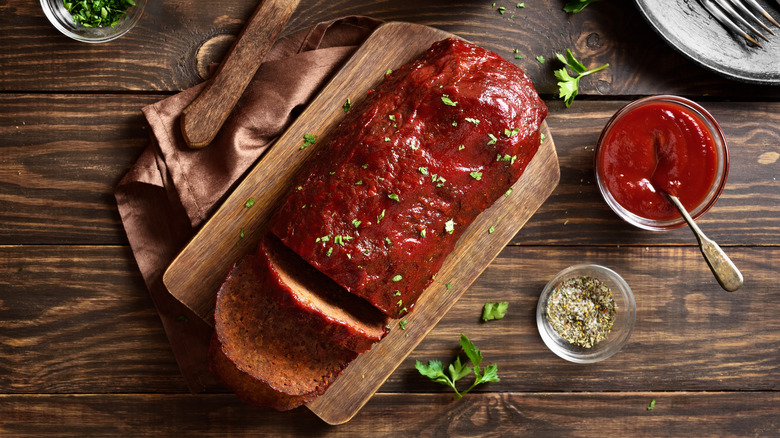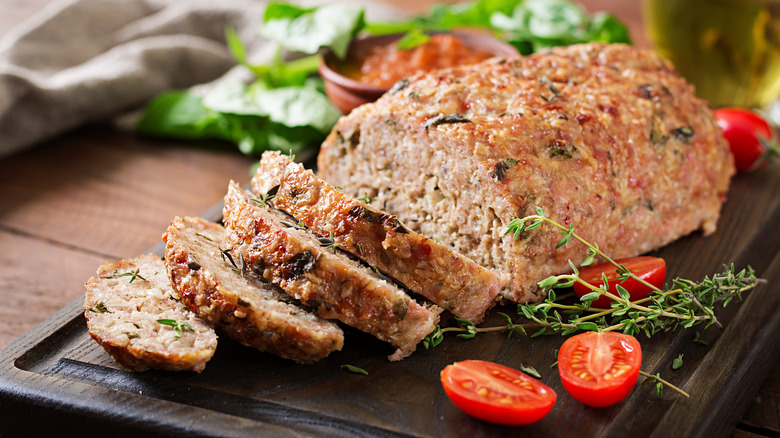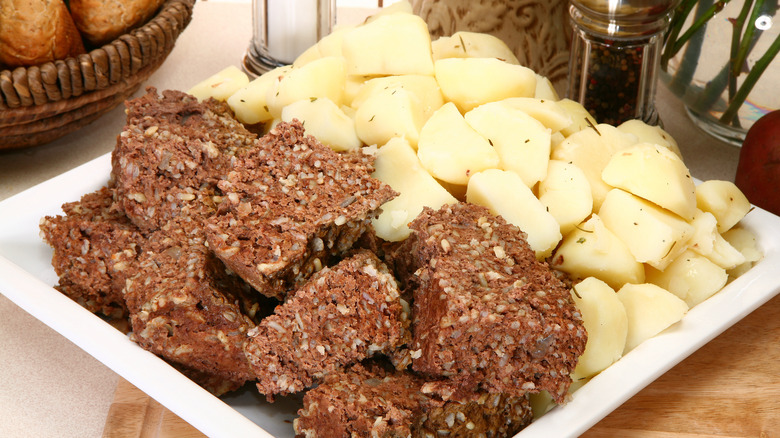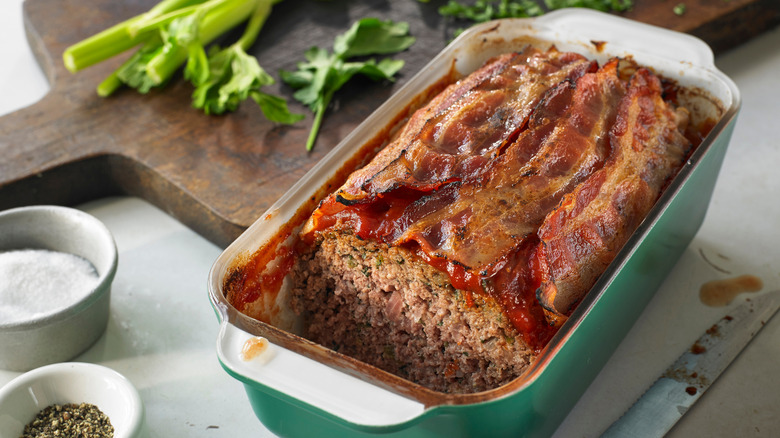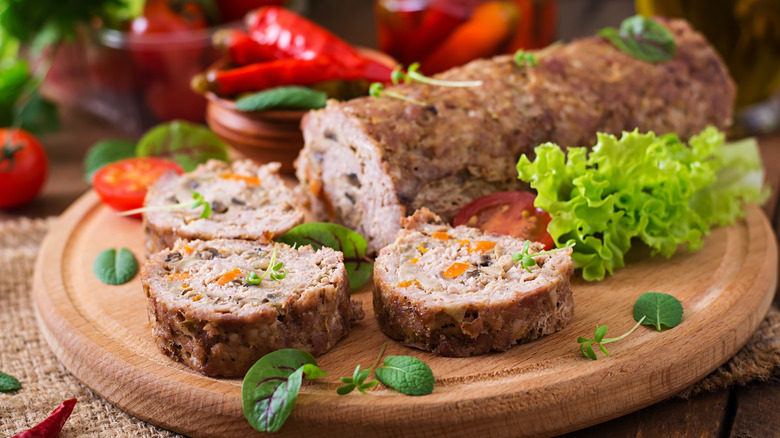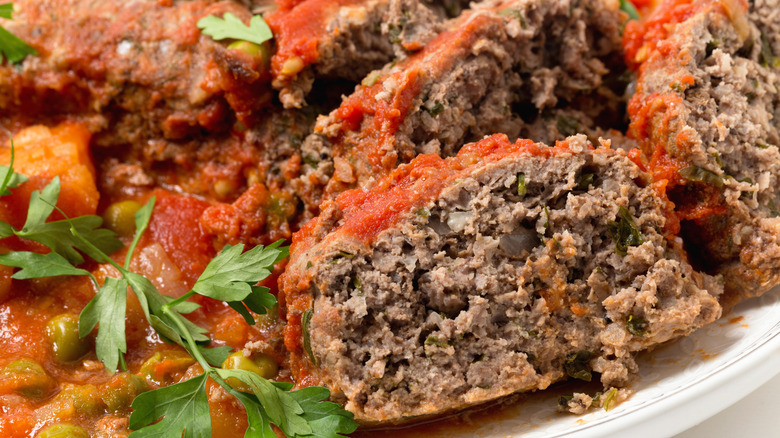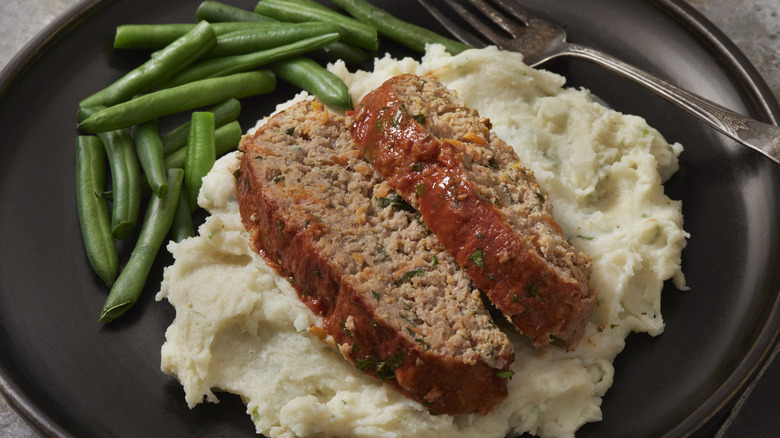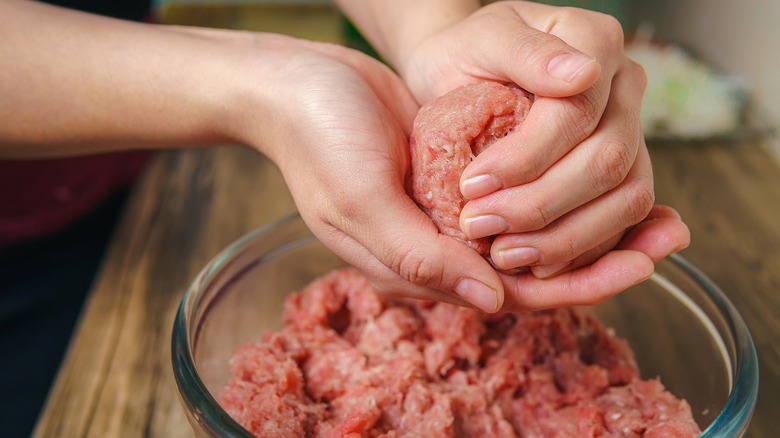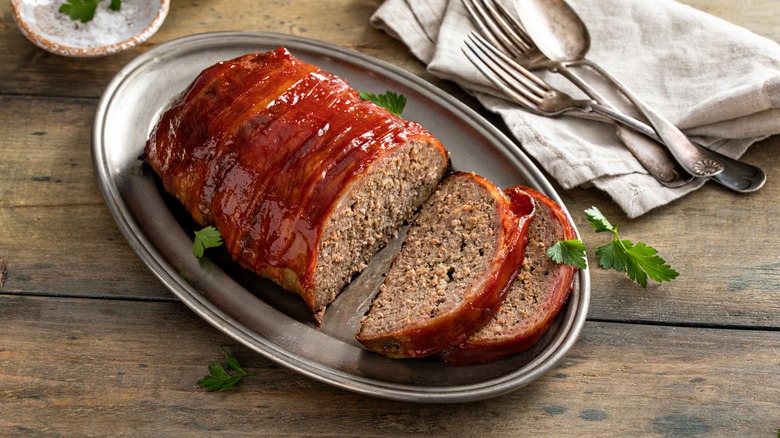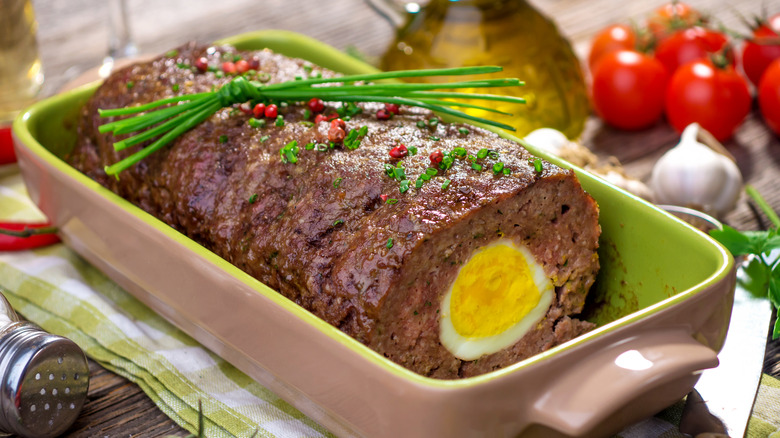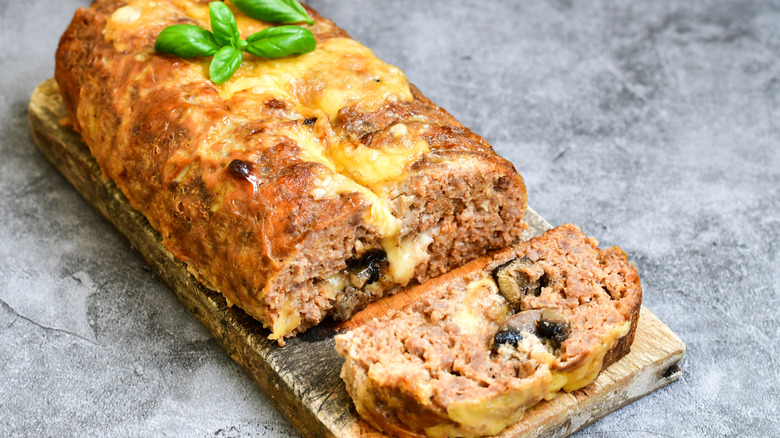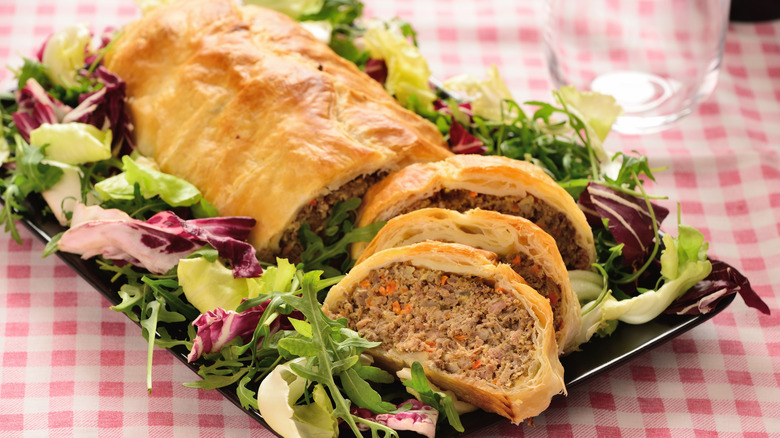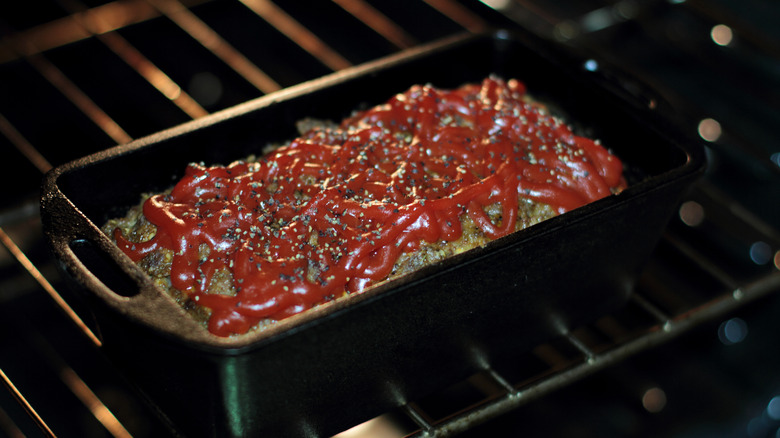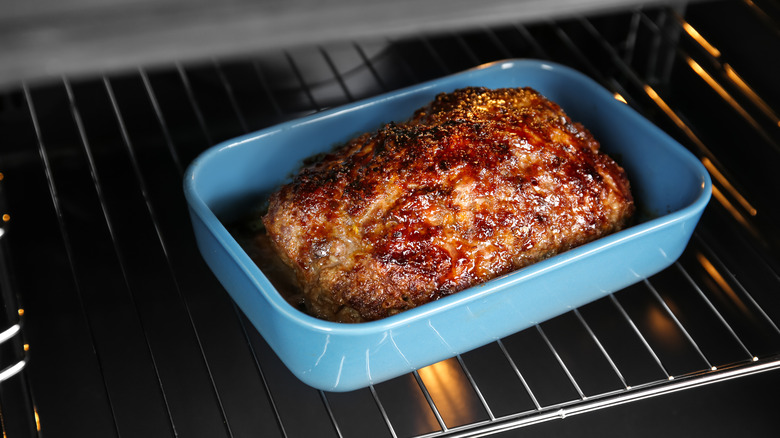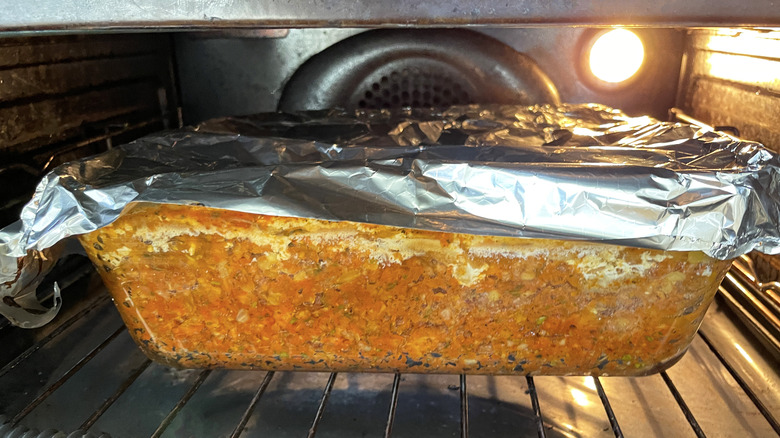15 Tips For Making The Best Meatloaf
Few dishes elicit a sense of nostalgia and comfort the way a piping hot meatloaf does. Whether it be a weeknight meal, a blue plate special at a throwback diner, or an elevated iteration of meatloaf baked sous vide in a fine dining restaurant, the legacy of meatloaf in American culture is representative of how our society has evolved through some of the most monumental historical events, including the Great Depression, World War II, and the 1970s.
While the first meatloaf recipe in America, a breakfast dish, appeared in the 1870s, it is believed that meatloaf originated in medieval Europe around the fifth century. Early recipes focused on combining cheap cuts of meat with bread and wine. Later variations eliminated the wine, introducing a myriad of seasonings and eventually incorporating novelties like ketchup.
Taking ground meat and stretching it with other ingredients to feed a crowd is efficient, affordable, and addresses the issue of food waste. The key is to do so while making your meatloaf moist and delicious. The following tips will help you to create the best and most juicy meatloaf ever.
1. Use a mixture of meats
Though ground beef is considered the classic choice for making meatloaf, using only one type of meat limits flavor and texture, the best meatloaf requires combining various types of meat. Effective combinations can include beef, pork, and sausage, though incorporating ground chicken or turkey can provide a more complex flavor and texture.
One key to keep in mind, however, is the fat content of the meat. To ensure ground meat is thoroughly cooked through in the oven, a meatloaf will often spend up to an hour baking. This lengthy cooking time can dry out your meatloaf if you do not incorporate enough fat into your meat mixture. When selecting ground beef, choose meat with a lean-to-fat ratio of 80/20 or 85/15. When opting for poultry, search out ground dark meat chicken or turkey, which utilizes thighs and drumsticks, or find ground poultry indicating a lean-to-fat ratio of 85/15, comparable to ground beef.
If you add sausage to your mixture, go easy with the amount you add. Most sausage recipes call for a lean-to-fat ratio of 70/30, but some may be as high as 50/50. This can make your meatloaf a bit greasy. You should also check the seasonings in the sausage you use to avoid over-seasoning your meatloaf mix. It is easy to add more seasoning, but you can't remove it once you have added too much.
2. Try game meats
Wild game is a flavorful and potentially healthier option for making meatloaf. According to Livestrong, due to the type of diet game animals consume, their meat tends to be lower in inflammatory omega-6 fatty acids and higher in anti-inflammatory omega-3 fatty acids, which may help to combat the onset of diabetes, cancer, and rheumatoid arthritis.
Game meat typically gets divided into three categories; winged game, ground game, and big game. When making meatloaf, we generally opt for the big game, such as bison, venison, elk, goat, or wild boar, although ostrich is also delicious. The key to cooking with game meat is to understand its uniqueness, namely that it is leaner, which can make obtaining a juicy meatloaf challenging.
The first solution is to add moisture by incorporating water, stock, milk, ketchup, barbecue sauce, or cooked vegetables, like sautéed mushrooms. You can also supplement the game meat with sausage or ground beef, which adds back some fat, though this may offset some potential health benefits. And finally, don't overcook game meat. Most game meat should get cooked to an internal temperature of 165 degrees Fahrenheit, which means at about 160 degrees Fahrenheit, you will want to remove your meatloaf from the oven and allow it to rest, during which the internal temperature will rise another 5 degrees Fahrenheit.
3. Use an alternative to breadcrumbs
Incorporating breadcrumbs and eggs into a meatloaf recipe is standard operating procedure. Typically the ratio is approximately ¼ breadcrumbs to ¾ meat in the mixture. The use of breadcrumbs has several purposes. They enable you to extend the protein to feed a bigger crowd. Second, the breadcrumbs help retain moisture in your meatloaf, keeping it from drying out during the lengthy baking process. And finally, breadcrumbs help to hold your loaf together as long as you don't add too much to the mix.
If you don't have breadcrumbs, are looking to switch things up a bit, or are gluten intolerant, you may wonder what other options you have to substitute them. Luckily the possibilities are virtually endless. Adding stale bread or croutons is common and salty snacks like crackers, potato chips, pretzels, and pork rinds that have been crushed are also great. Ground nuts, like almonds, pecans, or hazelnuts, will increase protein and boost the flavor. And breakfast staples like cereal or oatmeal can provide some additional fiber. Lastly, par-cooked rice provides additional texture; just be sure to lower the amount to accommodate swelling as the meatloaf bakes.
Regardless of what you use to bind your meatloaf, always soak it in milk or chicken stock before adding it to your meat mixture. This prevents the binder from absorbing too much moisture or fat from the meat, keeping the final product more tender.
4. Don't forget the vegetables
No meatloaf would be complete without incorporating some vegetables into the mixture. Not only do they impart flavor, but they will also enhance moisture, increase nutritional value, and further extend the meat to feed more people. It is also a sneaky way to get kids to eat more vegetables without them noticing.
The key is to dice your vegetables into smaller pieces, cook them thoroughly, and cool the cooked vegetables before adding them to your meat mixture. Cooking is crucial for a few reasons: It ensures that the vegetables don't stay crunchy, which would destroy the texture of your meatloaf. It also eliminates too much excess moisture, which may cause your meatloaf to fall apart. As a bonus, it amplifies the glutamate in vegetables, increasing their umami flavor.
Though you can utilize virtually any vegetable you like, this is the perfect opportunity to use ugly produce or produce that is on its last legs. These may not be attractive to eat alone, but when combined into a meatloaf, people will not notice. This is also a great chance to eliminate food waste by repurposing leftovers, like steamed broccoli, stir-fried carrots, braised spinach, or roasted squash.
5. Spice things up
Adding heat to your meatloaf recipe can amp up the flavor and add a touch of moisture, depending on what type of spice you use. The key is not to overdo it. There is a fine line between the heat that warms your mouth and throat, amplifying all the other flavors in the dish, and the spiciness that desensitizes your taste buds, making your nose drip and causing your stomach to turn.
For a modest amount of heat that is easy to control, you can start with dried spices, like cayenne pepper or red pepper flakes. Alternatively, add some heat using Tabasco, Sriracha, hot sauce, harissa paste, salsa, or chipotles in adobo sauce. Use a more conservative approach by incorporating these to find that ideal balance. And finally, you can add fresh chopped peppers of varying spiciness along the Scoville scale, like poblanos, jalapenos, serranos, or habaneros, if you feel super adventurous.
If you accidentally use too much heat, try tempering it by incorporating a touch of acidity in the form of lemon or lime juice or vinegar, adding ketchup, or adding a bit of extra milk to the mixture without oversaturating the meat. And always use gloves and wash your hands thoroughly when handling hot chili peppers.
6. Seasonings are key
It goes without saying that salt and pepper are indispensable to seasoning meatloaf. We want you to think beyond the basics here. Numerous different spices and dried herbs can get incorporated into your meat mixture, taking your meatloaf from mediocre to marvelous. While you can stick with classic combinations, like taco seasoning, Cajun seasoning, or Italian seasoning, we like to make things more exotic. Think about taking a tour of the globe through your meatloaf using combinations of spices like za'atar, ras el hanout, curry powder, Chinese five spice, garam masala, baharat, berbere, dukkah, or togarashi.
Alternatively, consider adding various condiments, sauces, or fermented ingredients that confer extra umami flavor to your meatloaf. These may include soy sauce, miso paste, fish sauce, Worcestershire sauce, Marmite, oyster sauce, tomato paste, or molasses. Other great options are kimchi, sauerkraut, pickles, yogurt, kefir, cottage cheese, tempeh, or natto.
When seasoning your meatloaf, use a delicate hand. Add a little at a time and do a quick taste test by frying up a bit of the meat blend to ascertain if it is adequately seasoned. You can always add more seasoning, but you cannot undo over-seasoning the meat.
7. Grease your hands before mixing
When making meatloaf, burgers, or meatballs, the worst thing you can do to your meat mixture is to overmix it. Doing so will yield a tough, dense final product that is dry and chewy. For this reason, most experts recommend mixing your meat by hand rather than using a stand mixer or food processor. The problem is that the ground meat tends to stick to your hands due to the discharge of the protein myosin, which reacts to the heat in the palms of your hands, making it difficult to get an even blend with minimal interaction with the mixture.
So how do you keep the meat from sticking to your hands? There are a couple of tricks you can utilize. First, you can wet your hands with cold water, which will help mitigate the heat released by your hands. You can also use disposable gloves, although we think it is more challenging to assess whether or not the meat mixture is thoroughly combined with that extra layer between your fingers and the meat.
Our favorite method of keeping meat from sticking to your hands is to grease your hands with a small amount of oil before diving in. This will create a layer between you and the mix, allowing it to slide across your palms rather than adhering to them. If you begin to notice the grease has worn off, add a bit more. The extra fat will also help moisten the meatloaf.
8. Bacon makes everything better
When it comes to meatloaf, this is not a hyperbolic statement. It makes it better by keeping it moist and giving it extra flavor. You can incorporate bacon into your meatloaf recipe in two ways; directly into the mix or encasing the loaf.
First, try incorporating bacon directly into your meat mixture. This requires cooking the bacon until it is barely crisp but not fully browned. You can accomplish this by baking it in the oven or frying it in a pan. Once the bacon has cooled completely, chop it finely with a knife or by pulsing it in a food processor. These bacon bits can then be added to the meat mixture and combined with your eggs, breadcrumbs, and seasonings of choice.
The other way to add bacon to your meatloaf is to encase the meatloaf in bacon. You can wrap it or get fancy by creating an elaborate lattice pattern. The first way to do this is to shape a free-form loaf on a baking sheet lined with foil. Layer the bacon over the meatloaf, tucking the ends of each piece just slightly under it without wrapping it tightly, allowing for shrinkage during the baking process without yanking the bacon off. Alternatively, layer the bacon into a loaf pan, add the meat mixture, and then bake as usual. Once the meatloaf is done, turn the loaf over onto a baking sheet and finish it under the broiler to help crisp up the bacon.
9. Add eggs
Adding eggs to the mixture of a meatloaf recipe is common. That's not what we are talking about here. We are talking about a recipe from the old country: Wrapping your meatloaf around hard-boiled eggs. This recipe, called Klops, is often associated with Jewish communities from Poland, although it can be found all over Europe. The dish is commonly served around the holidays.
While the meatloaf would have been made with ground pork in Poland, other meat, including beef, became popular elsewhere as the recipe migrated across the continent. The meatloaf can either be baked in a loaf pan or free form on a baking sheet. When you get just the perfect slice of meatloaf with the cross-section of egg in the center of it, it is visually stunning and delicious.
Consider soft boiling your eggs rather than hard cooking them for the best results. This will keep the yolk a bit brighter in color and not quite as dry after the dish has finished baking in the oven. For a play on Klops, try using quail eggs and making individual meatloaves. This would be a delightful addition to Easter festivities.
10. Cheese it up
Incorporating shredded cheese into meatloaf isn't a novel idea. Many recipes call for adding cheese to the meat mixture to help provide flavor, moisture, and texture. What few discuss is why it is crucial to choose the correct cheese. Some cheeses do not melt as well as others. In the case of meatloaf, cheese with the optimum melting point is indispensable.
Meltability is a product of a few elements where cheese is concerned. For a cheese to melt, the proteins within the cheese must be encouraged to denature. This is best achieved with cheeses that are high in fat, abundant in moisture content, lower in acid and have not been overly aged, which often causes cheeses to become drier.
The best cheeses for this purpose are Colby, cheddar, Swiss, and Monterey Jack. You might also try using gouda, muenster, fontina, asiago, or provolone for a more complex flavor. And if you happen to be making a spicy meatloaf, pepper jack would be ideal. Although brie, blue cheese, and goat cheese melt relatively well, these cheeses taste far too dominating and could easily overwhelm your meatloaf. And finally, though processed American cheese melts well because it is so gooey, it may cause your meatloaf to crumble, so we'd skip it.
11. Make individual loaves
As a culture, we appreciate individualism. From cupcakes to personal pizzas to single-serving Beef Wellington, being served your own helping of food makes it feel special. This is no less relevant when it comes to making meatloaf. Individual meatloaf is easy to dish up, looks nicer on your plate than a slice, and cooks much faster than a whole meatloaf.
The key is not to make a meatloaf look or feel anything like a hamburger or a meatball. Though you can free-form individual loaves and bake them on a cookie sheet, you can also purchase single-serving loaf pans. Alternatively, consider making individual meatloaves using muffin tins. These are not only adorable, but they are also super popular with kids.
Be sure to adequately grease your muffin pan before distributing your meatloaf mixture to prevent it from sticking. You will also want to closely monitor the temperature of your meat with a digital thermometer so that you don't overbake them. These will cook through in roughly half the time as a full-sized meatloaf, maybe even less. And finally, this is the ideal time to double the recipe and bake twice as many as you need. These freeze brilliantly in an airtight container or Ziploc freezer bag for up to six months for a quick and easy last-minute meal.
12. Wrap it in puff pastry
Beef Wellington is an iconic dish that became popular in the 1960s because of its inclusion in Julia Child's legendary book "Mastering the Art of French Cooking" and its appearance on her television series "The French Chef." The problem with Beef Wellington is that it is expensive to procure a whole beef tenderloin, making this a dish you wouldn't want to serve regularly.
The solution? Make a Meatloaf Wellington. Not only does baking in puff pastry help keep the meat moist, the juxtaposition between the tender loaf and the crispy crust is delectable. It also looks beautiful when sliced and presented on a dinner plate. In fact, you may never make another recipe for a dinner party again.
The key is to ensure your meat is thoroughly cooked before the puff pastry burns. There are two ways to accomplish this. First, you can pre-bake the meatloaf, cool it, then wrap it in your pastry crust before baking until the meat is heated and the pastry is golden brown. Alternatively, put your uncooked meatloaf mixture into the puff pastry and cover it with aluminum foil. Bake for approximately 30 minutes before removing the foil to finish baking uncovered, which will crisp up the pastry crust. The latter method is quicker and easier, although the pastry crust can sometimes become a bit soggy on the bottom.
13. Mix up your glaze
Adding a glaze to your meatloaf provides both flavor and moisture. That said, it is time that we started thinking outside the ketchup container and looking at alternative glazes to jazz up your loaf. A standard classic, mustard-flavored, or chili-infused barbecue sauce is a sensible alternative for a zing. For meatloaf with an Italian twist, consider a homemade pesto, balsamic glaze, or marinara to coat your loaf. For an exotic spin, try an Argentinian chimichurri, Moroccan chermoula, Indian green chutney, or Spanish romesco sauce.
If a glaze isn't your thing, consider a sauce to serve alongside your meatloaf. This can be as simple as a brown gravy or a mushroom cream sauce, although we are partial to something with a more international flair. Greek tzatziki or Indian raita is refreshing and pairs remarkably well with spicy meatloaf. For a meatloaf with a more Asian flavor, you may consider Korean ssamjang, gochujang, or a spicy peanut sauce. Or, for something with a decidedly Southern taste, try a sawmill, red-eye, or chocolate gravy.
14. Bake at a low temperature
There is a fine line between an underdone and an overdone meatloaf. The key is to ensure the meat is thoroughly cooked while the exterior develops a crust. If your oven is set at too hot a temperature, this will dry out the meatloaf, or the outside may burn before the center is cooked. For this reason, it is recommended that you bake your meatloaf at a temperature of no higher than 350 degrees Fahrenheit. At this oven setting, a two-pound loaf should take approximately one hour to reach the ideal internal temperature.
The second critical element to ensuring your meatloaf is well cooked is consistently checking the internal temperature with a digital thermometer. Every oven is slightly different in terms of how well it maintains heat. Therefore, we begin monitoring the internal temperature of the meatloaf at about the 40-minute mark. The ideal safe temperature for cooking ground meat should be around 165 degrees Fahrenheit. Though many will wait for the meatloaf to achieve that temperature before removing it from the oven, we often take it out at about 160 degrees Fahrenheit, which factors in any carryover cooking that may occur while the meat rests. This will help keep the meatloaf from drying out.
15. Cover your meatloaf while it rests
The final step to making the best meatloaf is to give it plenty of time to rest after removing it from the oven. Like with any meat, as it roasts or bakes, moisture from the protein will begin to work its way out of the muscle fibers, with some evaporating and the rest getting trapped toward the exterior of the loaf. If you were to cut right into the meatloaf, all that moisture would dribble onto your plate and away from the meat, making it dry. By allowing it to rest, these juices will redistribute themselves throughout the meatloaf, rendering it moist. Resting also allows the loaf to set, making it easier to cut into slices without falling apart.
While many recipes do not indicate this, we always recommend wrapping your meatloaf in foil like a tent while it rests. This will not only retain more moisture, but it will also help the meat hold its temperature and achieve any carryover cooking. The ideal resting time for a meatloaf is between 15 and 20 minutes. Should you be concerned about the crust losing its crispiness, you can always pop the meatloaf under the broiler for a minute before serving. The only exception to the tenting rule is if you are making a bacon-wrapped meatloaf. The bacon behaves like a wrapper encasing the meat while sealing in those juices.
